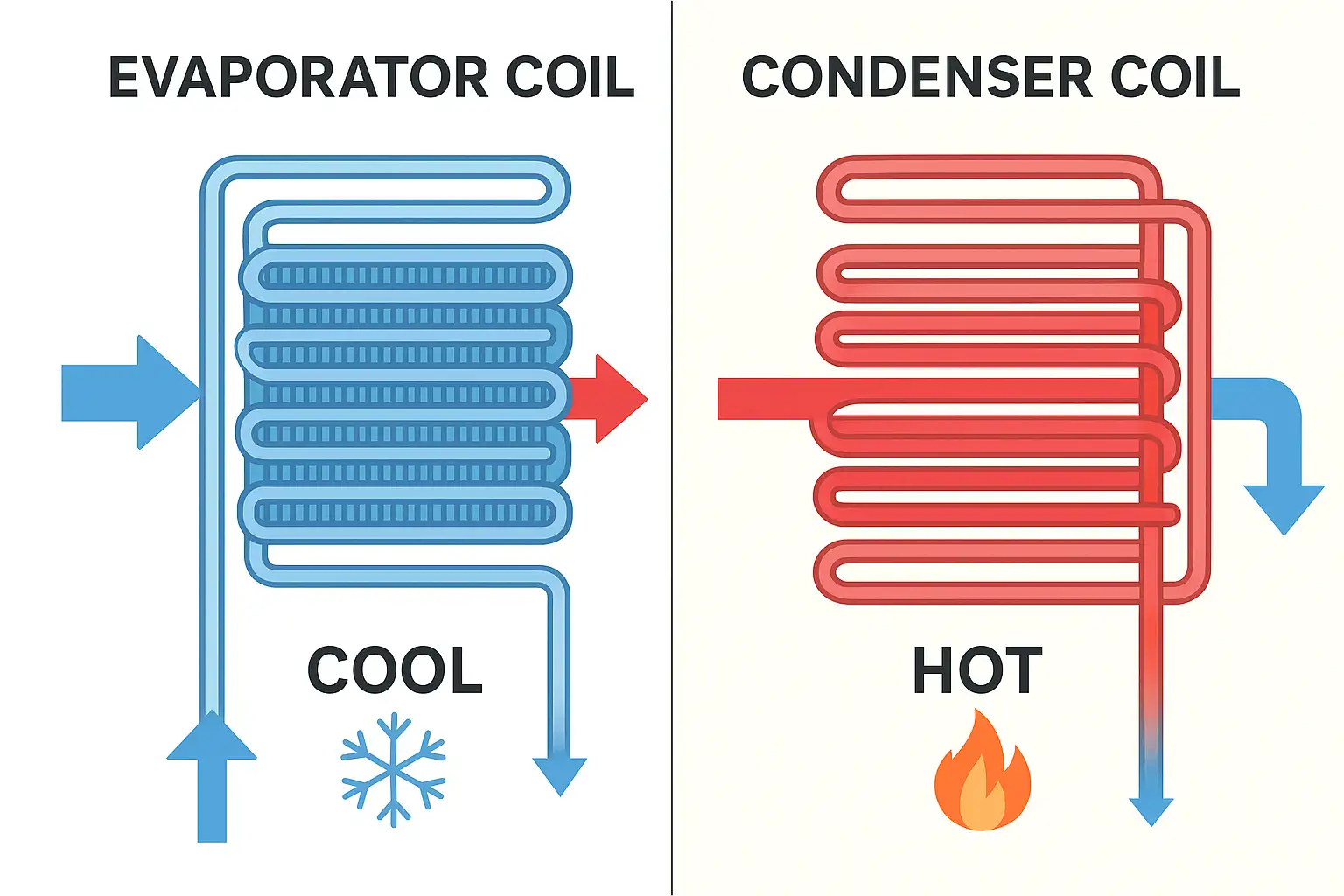Evaporator Coil vs Condenser Coil: which one is better? Well, if you want a reliable and desired performance of HVAC, then you need to learn about the insights. It will help you in planning everything according to your needs, such as functions, cost, and maintenance.
However, every heat pump or air conditioning system consists of two major components. One is the evaporator coil, and the second one is the condenser coil. They work their best to provide heating and cooling to make your building comfortable to live in. That is why we have prepared this guide to help you understand the differences between these two coils and their specific functions.
READ OUR GUIDE TO EXPLORE EVAPORATOR COIL VS CONDENSER COIL TO PREVENT DIRTY COILS LEADING TO EXPENSIVE REPAIRS AND PREMATURE SYSTEM FAILURE!
What are the major Differences?
Evaporator Coil
The evaporator coil is the indoor element of the HVAC system. It is located within the air handler, furnace, or mounted on the wall in ductless systems. Its main use is to absorb the heat from the indoor and pass it over the coil’s surface. Let’s explore the main functions:
- Heat Absorption: Removes heat from warm indoor air flowing over the coil
- Phase Change includes converting liquid refrigerant to gas as it absorbs heat
- Delivers cooled air back into the space
- Removes moisture from the air
Condenser Coil
On the other hand, the condenser coil is located in the outdoor unit of your HVAC system. The main purpose is to release the heat that is collected from the evaporator coil into the outdoor environment. Hence, the main functions are:
- Expels absorbed indoor heat to the outside air
- Converts gaseous refrigerant back to liquid form
- It uses outdoor air to cool the refrigerant
How do They Work Together?
- With the help of a fan, warm air is pulled through the air conditioning system. It then flows over the evaporator coil.
- After that, the warm refrigerant travels through the insulated lines.
- A compressor helps increase cold pressure and temperature
- As soon as hot refrigerant vapor travels through the condenser coils, it comes into contact with the outside air.
- The refrigerant condenses back in liquid form
- After that, the liquid cold goes back to the coil to start the cycle again
The cost of Evaporator Coil Replacement
Total Replacement Cost Range
- Standard Systems range between $600 – $3,700
- Mini-Split Systems range between $1,900 – $2,300
- Heat Pump Systems range between $2,100 – $2,500
Cost Breakdown by System Size
- 1.5-2 Ton System: $600 – $1,400
- 3 Ton System: $800 – $1,800
- 4-5 Ton System: $1,600 – $2,400
Factors Affecting Evaporator Coil Costs
1. Coil Type
- A-coils (most common): Standard pricing
- N-coils or Z-coils: 15-25% higher due to increased efficiency
- Slab coils: Least expensive, most compact option
2. Cased vs. Uncased
- Cased coils: A cased coil costs an average of $1,000 and slides in easily because the fit is forgiving
- Uncased coils: An uncased coil averages $800, but installation is fussier since every edge must line up precisely
3. System Type Impact
- Gas Furnace Systems: $630 – $2,310 (easier installation)
- Heat Pump/Electric Systems: $870 – $3,700 (more complex installation)
Condenser Coil Replacement Costs
Total Replacement Cost Range
- Condenser Coil costs between $900 – $2,300
- Complete Condenser Unit expense ranges between $1,200 – $4,200
Labor Expense
AC experts charge $75 to $150 per hour for labor. The charges depend on the location, but the time varies. However, the evaporator coil takes 2-4 hours, and the condenser coil takes 4-8 hours.
Professional Cleaning and Maintenance Costs
- Evaporator Coil Cleaning expense range between $100 to $400
- Condenser Coil Cleaning takes $75 to $230
- Both Coils Together starts at $175 but can range up to $900
Deep Cleaning Services
- Acid Wash takes $300 and $350 for heavily soiled outdoor units
- Additional $300+ for severely dirty coils requiring hands-on scrubbing
How to save costs?
Many HVAC companies offer annual service contracts that include:
- Regular coil cleaning
- Filter replacement
- System inspections
- Priority service calls
- Discounted repair rates
Proper Cleaning
If you clean the coils, you can:
- Reduce energy consumption by up to 30%
- Extend equipment lifespan by 3-5 years
- Prevent expensive emergency repairs
- Maintain the best indoor air quality
Final Verdict!
To sum it up, now you may have easily understood the difference between the evaporator coil and the condenser coil. However, if you regularly maintain your systems, you can save on your overall expenses. Keep in mind, proper care will extend the life of each and every type of system. You can also prevent expensive emergency repairs. Hence, by understanding evaporator and condenser coils and all other guidelines that we have mentioned. Your HVAC system will provide the best comfort and reduce unexpected expenses.

